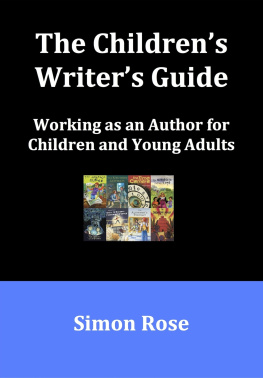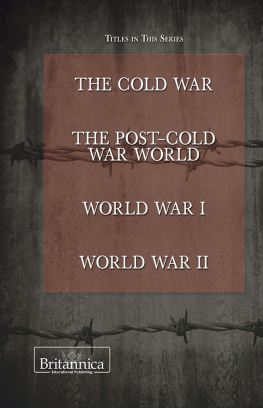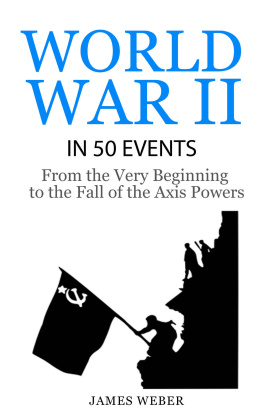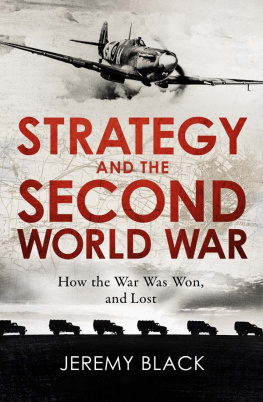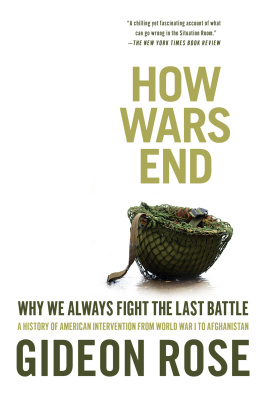INDEX
Allied forces,
Victory in Europe Day,
Victory over Japan Day,
Axis powers,
battles
Britain,
Bulge, the,
Coral Sea, the,
El Alamein,
Guadalcanal,
Iwo Jima,
Kursk,
Leningrad, siege of,
Midway,
Okinawa,
Saipan,
Stalingrad,
China,
Eastern Front,
France,
liberation of Paris,
Germany
Blitz,
Hitler, Adolf,
Luftwaffe,
National Socialist German Workers Party (Nazis),
Great Britain,
Chamberlain, Neville,
Churchill, Winston,
evacuations,
Royal Air Force,
Holocaust,
invasions
Asian colonies,
Austria,
Czechoslovakia,
D-Day,
France,
Operation Barbarossa,
Poland,
Italy,
Mussolini, Benito,
Japan
aggression,
Pearl Harbor attack,
Second Sino-Japanese War,
resistance groups,
Soviet Union,
joining the Allies,
Rokossovsky, Konstantin,
Stalin, Joseph,
United States
aid to other countries,
atomic bomb attacks,
joining the Allies,
Navajo code talkers,
Roosevelt, Franklin D.,
Tibbets, Paul,
Truman, Harry,
World War I,
CHAPTER 1
PRELUDE TO WAR
D ecember 7, 1941, dawned as a typical Sunday at the U.S. Navy base in Pearl Harbor, Hawaii. Many sailors were on shore leave, some were still in bed or eating breakfast, and a few were on duty aboard the warships docked in the harbor.
At 7:55 a.m. that peaceful day was shattered. Japanese planes roared through the sky over the harbor, raining deadly bombs in a surprise attack. Two hours later more than 2,400 Americans were dead, and the United States was plunged into the most devastating war the world has ever seenWorld War II.
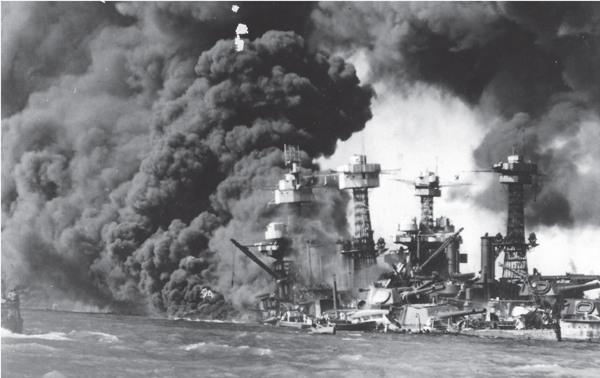
Japanese bombs sank the USS West Virginia at Pearl Harbor.
BEGINNINGS OF WAR
World War II actually began in September 1939, but the United States managed to stay out of it until the attack on Pearl Harbor. U.S. allies such as France and Great Britain, however, were part of the war from the beginning.
The seeds of the war were sown more than 20 years earlier, at the end of World War I. When the Treaty of Versailles was signed in 1919, many people breathed a sigh of relief. After years of fighting and more than 15 million deaths, the world was at peace.
But not everyone was pleasedespecially the Germans, who lost the war. The treaty forced Germany to give up much of its territory and all of its colonies. Germany was also forced to pay for the cost of the conflict. Resentment at the treaty terms would be a key part of the rise of Adolf Hitler and the National Socialist German Workers Party, the Nazis.
Germany did have one allyItaly. Although Italy had a king, Prime Minister Benito Mussolini ruled the country as a dictator. In 1936 Italy and Germany signed a treaty of friendship. Mussolini described the treaty as a Rome-Berlin axis. The alliance between Germany and Italy would later be known as the Axis powers.
TRYING TO AVOID WAR
In Britain and France, people were against more conflict. Political parties in these countries were divided on how to deal with the new threats to peace. When Hitler began flexing Germanys military muscle, Britain and France did their best to negotiate to try to prevent war. Negotiation often meant giving in to German demands.
In 1938 Germany was threatening Czechoslovakia. British Prime Minister Neville Chamberlain met with Hitler in Munich in an attempt to solve the Czech crisis. But that didnt happen. Germany, which had already invaded Austria, took over Czechoslovakia in 1939. Britain began to prepare for war.
Japan had been showing aggression against China since the early 1930s. In 1937 the Second Sino-Japanese War broke out between Japan and China, which led to Japans takeover of large parts of China. U.S. leaders were worried about Japanese expansion, and tensions increased between the two countries.
CHAPTER 2
19391940: THE EARLY DAYS
B ritain and France stood firm when Adolf Hitler and his armies invaded Poland on September 1, 1939. Two days later Britain and France declared war on Germany. The following spring Germany invaded Denmark and Norway. In May Germany unleashed its forces on the Netherlands, Luxembourg, Belgium, and France. Germanys rapid attacks were called the blitzkrieg, meaning lightning war.
Britain immediately sent military aid to mainland Europe, but Paris fell to the Germans June 14, 1940. France was defeated, and the British forces were pushed back to the English Channel. A massive
BATTLES IN THE AIR
In order to invade England, the Germans needed to take control of the narrow English Channel and the air above it. German bombs rained down on British airfields and cities, especially London, in what was known as the Blitz. The bombing left many people dead, injured, or homeless.
During the summer Royal Air Force pilots fought the German air force, the Luftwaffe, over the skies of southern England in the Battle of Britain. More than 500 RAF pilots were killed, and the country was very close to defeat. Churchill praised the bravery of the British pilots, stating that
Instead of giving up, the RAF increased efforts against the Luftwaffe. The RAF scored a decisive victory September 15, destroying 55 German aircraft. Hitler canceled the invasion two days later, but the bombing continued until spring 1941. Throughout Britain 60,000 people were killed and 87,000 seriously injured during the Blitz.
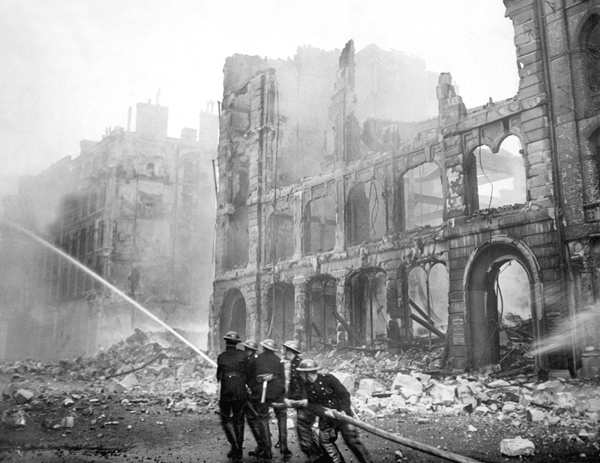
Firemen worked to control fires during the Blitz attacks on London.
THE ROLE OF THE U.S.
Although not yet directly involved in the war, the United States sent ships, supplies, and weapons to Britain, angering Germany. German torpedoes hit the USS Reuben James October 31, 1941, making it the first American ship lost to enemy attack during the war.
In the meantime, the United States was keeping an eye on events in the Pacific and East Asia. Relations between the U.S. and Japan continued to worsen because of Japans ongoing war with China. Both the U.S. and Europe were concerned about Japanese intentions toward Asian coloniesthe American-ruled Philippines, French Indochina, the Dutch East Indies, and the British colonies of Hong Kong, Singapore, Burma, and Malaya. In September 1940 Japan signed a treaty with Germany and Italy, becoming part of the Axis powers.
CHAPTER 3
1941: THE ALLIES EXPAND
A s Britain struggled to survive, Germany made its biggest move yet. In June 1941 the German army launched Operation Barbarossa, a massive invasion of the Soviet Union. Britain and the United States offered help to the Soviet Union, leading the country to join the Allies. Soviet leader Joseph Stalin was determined to resist Germany, saying in July 1941,
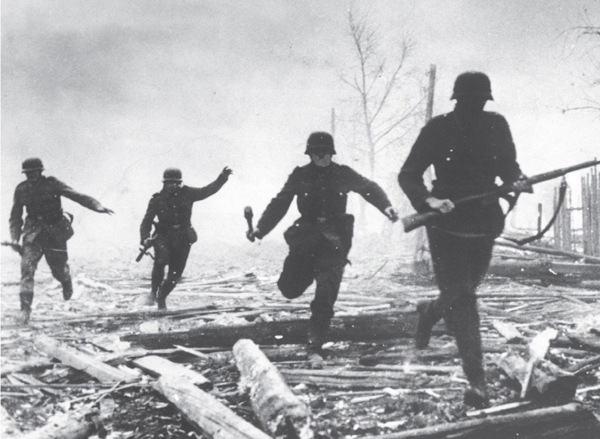
German soldiers were successful during the early days of Operation Barbarossa.
The Germans didnt let Stalins words stop them. They advanced quickly, pushing the Soviet armies back and taking huge numbers of prisoners. German soldiers moved toward Moscow and Leningrad, Russias major cities. The soldiers were only 15 miles (24 kilometers) from Moscow at the end of 1941. Leningrad would endure a siege lasting 872 days, in which it is believed 1 million people died. Leningrad resident Nikolai Markevich wrote in his diary January 24, 1942, In Moscow a counter offensive by the Soviet army eventually pushed the Germans back, relieving pressure on the capital city.


